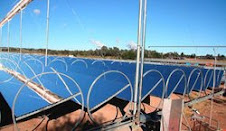Focusing on the Nexus of the Agriculture and Energy Value Chains
by Nathan Glasgow and Lena Hansen, RenewableEnergyAccess.com
Biofuels, and specifically ethanol, have been the subject of a great deal of criticism in recent months by detractors claiming that more energy is required to produce ethanol than is available in the final product, that it is too expensive, and that it produces negligible carbon reductions. These critiques are simply not accurate. State-of-the-art technologies have been competently forecasted-even proven in the market-to produce ethanol that is far more cost-effective and less energy-intensive than gasoline. We'll explore why, and why the critics have gotten it wrong.
When we say biofuels, we mean liquid fuels made from biomass-chiefly biodiesel and ethanol, which can be substituted for diesel fuel or for gasoline, respectively. The technology used to produce biodiesel is well understood, although its biomass feedstocks are limited and production today is fairly expensive. We will instead focus on ethanol, which we believe has significantly greater potential.
Ethanol, which can be substituted for or blended with gasoline, has traditionally been produced from either corn or sugarcane feedstocks. In fact, Brazil currently meets more than 25 percent of its gasoline demand with ethanol made from sugarcane. (The sugar is so cheap that the resulting ethanol sells in New York for $1.10 a gallon-with about 81 percent the energy content of a gallon of gasoline-after paying a 100 percent duty, illegal under WTO rules, to protect U.S. corn farmers. Undeterred, the Brazilians are merrily expanding their ethanol exports to Asia.) Even gasoline in the United States contains, on average, 2 percent ethanol (used as a substitute for MTBE to oxygenate fuel). American ethanol is almost exclusively made from the kernels of corn, accounting for about 7 percent of the corn crop. But conventional processes and feedstocks used to make ethanol are not feasible in the United States on a large scale for three reasons: they're not cost-competitive with long-run gasoline prices without subsidies, they compete with food crops for land, and they have only marginally positive energy balances.
Happily, in addition to starch-based feedstocks, ethanol can be produced from "cellulosic" feedstocks, including biomass wastes, fast-growing hays like switchgrass, and short-rotation woody crops like poplar. While not cost-competitive today, already observed advances in technology lead us to believe that in the next few years, ethanol made from these crops will become cost-competitive, won't compete with food for cropland, and will have a sizeable positive energy balance. Indeed, because these crops are expected to have big biomass yields (~10-15 dry tons/acre, up from the current ~5 dry tons/acre), much less land will be required than conventionally thought. Further, cellulosic ethanol will typically have twice the ethanol yield of corn-based ethanol, at lower capital cost, with far better net energy yield.
A common complaint about ethanol is that the quantity of feedstocks is limited and land used to grow feedstocks could be put to better use. For cellulosic feedstocks, the situation is quite the contrary. Cellulosic feedstocks are plentiful: for example, municipal and agricultural wastes can be used to create ethanol, with the positive side-effect of reducing the quantity of waste we must dispose of. Using waste to produce fuel has the clear benefit of a virtually free feedstock, and because energy is generally expended to create the product, not the waste, this type of ethanol obviously has a positive energy balance.
Not quite as obvious is to what extent dedicated energy crops can be used to produce ethanol. We believe the answer is straightforward. Research by Oak Ridge National Laboratory shows that dedicated energy crops can be grown without competing with food crops because they can be grown in marginal areas unsuited for food crop production, or on about 17 million acres of Conservation Reserve Program land that is currently being withheld from agricultural use.
Cellulosic crops have additional environmental benefits for several reasons. First, because crops like switchgrass are deep-rooted perennials, growing them actually prevents soil erosion and restores degraded land. For this same reason, cellulosic crops also have significantly lower carbon emissions. While corn-based ethanol reduces carbon emissions by about 20 percent below gasoline, cellulosic ethanol is predicted to be carbon-neutral, or possibly even net-carbon-negative.
We can't remember how many times we've been asked the question: "But doesn't ethanol require more energy to produce than it contains?" The simple answer is no-most scientific studies, especially those in recent years reflecting modern techniques, do not support this concern. These studies have shown that ethanol has a higher energy content than the fossil energy used in its production. Some studies that contend that ethanol is a net energy loser include (incorrectly) the energy of the sun used to grow a feedstock in ethanol's energy balance, which misses the fundamental point that the sun's energy is free. Furthermore, because crops like switchgrass are perennials, they are not replanted and cultivated every year, avoiding farm-equipment energy. Indeed, if polycultured to imitate the prairies where they grow naturally, they should require no fertilizer, irrigation, or pesticides either. So, according to the U.S. Department of Energy, for every one unit of energy available at the fuel pump, 1.23 units of fossil energy are used to produce gasoline, 0.74 of fossil energy are used to produce corn-based ethanol, and only 0.2 units of fossil energy are used to produce cellulosic ethanol.
Critics further discount cellulosic ethanol by ignoring the recent advancements of next-generation ethanol conversion technologies. A recent example that has received significant attention is David Pimentel's March 2005 paper in Natural Resources Research, which argues that ethanol production from cellulosic feedstocks requires more fossil energy to produce than the energy contained in the final product. However, Pimentel bases his analysis on only one technology used to produce ethanol, ignoring two other developing technologies. His chosen conversion technology, acid hydrolosis, is the least efficient of the three.
A superior option, thermal gasification, converts biomass into a synthesis gas composed of carbon oxides and hydrogen. The gas is then converted into ethanol via either a biological process using microorganisms or a catalytic reactor. Both of these processes show good potential for increased energy yields and reduced costs by using cellulosic feedstocks. This conversion technology is currently being tested in pilot plants in Arkansas and Colorado.
Still better, enzymatic reduction hydrolosis already shows promise in the marketplace. Such firms as Iogen and Novozymes have been developing enzymes, and "smart bugs," that can turn biomass such as corn residues (leaves, stalks, and cobs) into sugars that can then be converted into ethanol. Historically, the biggest cost component of this technology was the creation of enzymes. Earlier this year, though, in combination with the National Renewable Energy Laboratory, Novozymes announced a 30-fold reduction in the cost of enzyme production in laboratory trials. Expected benefits from this process include low energy requirements, high efficiency, and mild process conditions. A pilot plant exists in Ontario and another is planned in Hawai'i. The first commercial-scale enzymatic reduction hydrolosis plant is scheduled to be built and operational by Iogen within two years, producing ethanol at a targeted cost of $1.30 per gallon.
No matter which of these conversion technologies ultimately wins, it is clear that cost-effective and efficient ethanol production from cellulose is on the horizon-which is good news for the United States, where mobility consumes seven of every ten barrels of oil we use. Our voracious appetite for that oil comes at a cost-we have to buy it, we have to deal with the pollution that comes from using it, and, because 12 percent of our oil comes from the Middle East, we have to defend it. Because mobility consumes 70 percent of the oil we use, mostly by burning gasoline, it's the first place to look for a solution.
Our recent publication Winning the Oil Endgame (www.oilendgame.com) shows that the critical first step to reducing our oil consumption is tripled automobile efficiency-which can improve safety, maintain or improve performance and comfort, and repay its extra cost (if any) within two years at today's U.S. gasoline prices. But there's no reason to stop there. Using biofuels instead of gasoline to power our cars has the potential to displace 3.7 million barrels per day of crude oil-that's a fifth of our forecasted consumption in 2025, after more efficient use. In fact, an 85/15 percent blend of ethanol/gasoline in the tank of RMI's designed 66-mpg SUV would result in the vehicle getting ~320 mpg per gallon of fossil fuel burned (because the majority of fuel burned is ethanol).
Clearly, focusing on the nexus of the agriculture and energy value chains will create huge opportunities for business and huge wins for our country. The critics simply have it wrong.
Nathan Glasgow and Lena Hansen are researchers/consultants at the Rocky Mountain Institute.
Renewable energy-related links and solar product ads:
Power your home with solar or wind power, visit the Alternative Energy Store!
gift tool to buy on the internet, xmas present for dad, find solar products for sale online, solar-powered gifts
buy solar electronics gadget, solar energy holiday gift, purchase sun-powered seasonal present, cool tools for sale on web, compare solar-powered radio-flashlights online, photovoltaic panel on radio
P2P File Sharing Software is NOT ILLEGAL! Get unlimited music downloads, movies, tips, tricks and all the help you ever wanted but were afraid to ask. Click NOW!
find music CDs online, rap hip hop reggae world music soul jazz rock, buy cd box set, find new music releases, purchase music gift
Jazz CDs and Box Sets
buy solar-powered electronics online, find solar gadgets, purchase solar calculator, buy photovoltaic electronics, solar energy powered electronics for sale online
Solar-powered Tools and Hardware
Solar Battery Recharger for sale online
Most Popular Electronic Gifts, at Amazon.com
For the ultimate in music downloads Click here
Solar Photovoltaic Books at Amazon.com
Solar-powered Electronics Gifts Watches
End of Solar and Clean Power links section






No comments:
Post a Comment